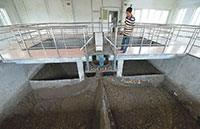Physicists on cutting edge in search for dark matter
By CHENG YINGQI (China Daily) Updated: 2015-12-18 07:21
 |
|
A scientist checks equipment designed for dark matter research at Jinping Underground Laboratory. SHEN BOHAN/XINHUA |
China is joining the global competition on a scientific frontier-the search for dark matter-with new research instruments and facilities in place that heighten anticipation for answers.
On Thursday, the Chinese Academy of Sciences launched the country's first dark matter satellite, which will be in service for three years to search for signs of the mystery substance, as well as to study the origin of cosmic rays and observe gamma rays.
"We hope we are lucky enough to become the first team in the world to find dark matter," said Chang Jin, deputy director of the academy's Purple Mountain Observatory.
Dark matter is extremely difficult to measure because it seldom interacts with anything, other than generating gravity. Most researchers trying to measure it using electronic or magnetic signals have reached a dead end.
However, Chang believes that when dark matter particles collide and annihilate each other, they generate other particles that can be detected-electrons, antiprotons and gamma rays. He proposed the idea when he joined the Advanced Thin Ionization Calorimeter project sponsored by NASA, the United States space agency, in 1998.
Between 2000 and 2003, the team launched a balloon-borne instrument over Antarctica to detect comic rays at low altitudes. It found excess electrons that may have been emitted by dark matter annihilations somewhere in space, perhaps 3,000 light years from Earth.
The discovery was reported by the journal Nature in 2008, as exciting indirect evidence for the existence of dark matter.
- China vows to tighten crackdown on terrorism
- Chinese scientist among Nature's ten people for 2015
- Physicists on cutting edge in search for dark matter
- Top information office holds record number of news conferences
- Shenzhen leaps to top of efficiency list in 2 yrs
- China aims to expand global FTA network
- Year's worst smog coming to north China
- China launches satellite to shed light on invisible dark matter
- China strongly opposes US arms sale to Taiwan
- Report: Layoffs may loom next year







